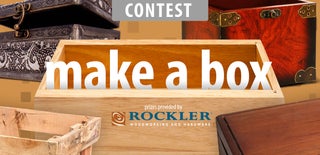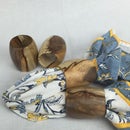Introduction: Turned Wooden Jewelry Box
I really enjoy creating things that I can give as gifts, best of all a gift for my wife. This wooden box is intended to hold her bracelets inside and several rings on top. A mainly make bowls so this box was a great change of pace. Its a great feeling being able to show your spouse what you have been working on in the shop and then say, O by the way its for you.
Step 1: Pre-shaping
A started by selecting a body of the box, a 6x6x3 dark wood blank. For the lid and finial I choose a plank of Black Walnut I had sitting around. The walnut was a little over 5" wide and 2" thick. As I got into the project I found this was bigger and thicker than I really needed. I used my bandsaw to make each piece of the box easier to turn. In the third image you can get an idea of how I intended it all to go together.
Step 2: Shaping the Outside of the Box Body
I like to screw a blank like this to a face plate for several reasons. The main reason is that I want to be able to finish the outside of the bowl on the first mounting. A face plate allows me to access the bottom of the bowl/box and finish it through final sanding. The middle picture shows the final shape of the box body. Once the bottom is finished I can remove the face plate and use my 4 jay chuck to hold onto the bowl. I sized the bottom to fit the jaws I have on hand. At this point I am now able to start hollowing out.
Step 3: Hollowing
This process probably requires more patients and skill then any of the other steps. I began by using my favorite bowl gouge, shown on the left, to begin hollowing out the box body. I then moved to a round carbide cutter to begin the under cut. I probably could have skipped using this tool but I wanted to see how well in worked! I finished up by using a goose neck hollowing tool. This tool allowed me to effectively remove material from under the lip of the box and achieve an even wall thickness throughout. The tool on the far right is my depth gauge. I measured on the outside of the box how deep I wanted to hollow the inside and then used it throughout the process to know my progress and insure that I didn't cut through the bottom (which is never any fun).
Step 4: Outer Diameter of the Lid
Now that the box body is completed we are able to move on to the lid. I will be using a drive screw mounted in my 4 jaw chuck to spin the lid. To accommodate the screw, I drilled a hole in the middle of lid that allowed for maximum grip of the threads. In the second picture you can see how I used a set of calipers to measure the outside diameter of the box opening and then transferred that dimension to the lid. I intentionally oversized this so that after sanding the lid it would still fit snug. For final sizing I used the best gauge I had, the box its self. I did this with the lathe off to avoid friction build up between the two pieces and potentially leaving burn marks.
Step 5: Inner Diameters of the Lid
Once I was happy with the largest OD of the lid I went to the smallest. I intend to use the same chuck jaws currently holding the drive screw when I finish the top of the lid. I measured the outer diameter of the jaws when closed and transferred that to the bottom of the lid. The first picture shows how I cut that dimension into the lid bottom, I will be able to expand the jaws in this recess and finish the lid. Next I begin forming the lid lip. Using the calipers again I transfer the diameter of the inner opening to the bottom of the lid. This will allow the lid to rest inside the box body. The third picture shows the final shape of the lid bottom. I added several decorative rings for fun. As you can see in the forth picture, the lid fits perfectly into the lower portion of the box.
Step 6: Finishing the Top Surface of the Box Lid
After removing the drive screw I am able to flip the lid over and expand the jaws into the lid, as shown in the first picture. To aid in a more robust lid to finial connection I drilled the hole out with a 1/2" drill. With the hole the size that I want I can move forward with shaping the lid top. This shape was completely decorative and could be modified however you want. One note is that near the drilled hole the surface slopes down. This will prevent visible gaps once the finial is pressed on.
Step 7: Lid Finial
After rounding the small finial blank and used a calipers to measure the actual ID of the lid hole and transferred that to an OD on the finial bottom. This will be the portion that is pressed into the lid. It is worth noting that I also undercut the surface that will rest on top of the lid. With both angled away from each other it should be very easy to not have a gap at assembly. The rest of the finial shape is once again artistic and up to whoever is shaping it. Once the finial is parted off we are ready for final assembly!
Step 8: Final Product!
With the bottom of the finial sized correctly you will now be able to press the finial into the lid and probably not need much glue to keep it locked in place. The initial picture might be a bit misleading. As soon as I parted of the finial it broke in half! I was reminded that grain orientation is super important when doing spindle work. I had decided to use the grain running perpendicular to the turning axis instead of parallel. Just a small amount of force caused it to snap at the thinnest point of the body.
I wasn't super happy with the finial shape so now I had an excuse to do something better. Using a small piece of Purple Heart and the same process that I used for the first finial I made a something that I am much happier with. I had never done a success off axis spindle before and I was surprised by how easy it was.
The best part about this project is that my wife loves her new custom jewelry box!
Step 9:

Second Prize in the
Make a Box Contest

Participated in the
Full Spectrum Laser Contest 2016













